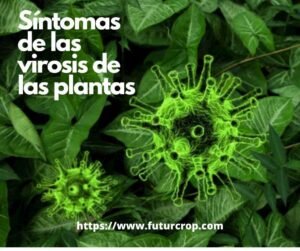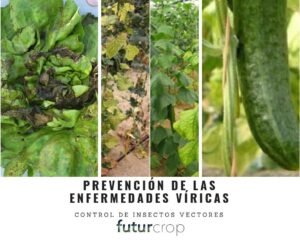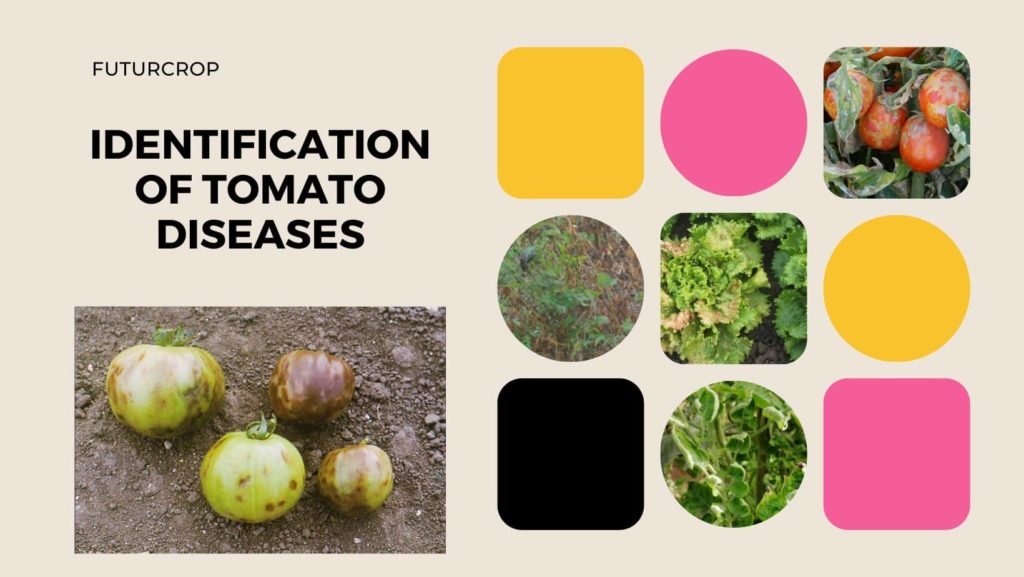
Contents
Symptoms of plant diseases
It should be borne in mind that the symptoms of plant diseases are very dependent on the conditions of the infected plant:
- The variety of the host, within the species.
- Environmental conditions, especially temperature.
- The stage of physiological development of the infected plant. The smaller, the greater the damage caused by the disease and the more obvious the
symptoms may be. - The level of nutrition of the infected plant also conditions the symptoms, distorting the normal symptoms of the disease.
Control of plant diseases
The two strategies that have the best impact on the control of viral plant diseases are the prevention of infection and the use of varieties resistant to the disease.
In this regard, the following measures can be taken:
- General measures such as removing and destroying infected plants, buying healthy transplants, using resistant varieties, properly managing weeds as they can be hosts for the disease, the transmitting insect or both.
- When the disease is transmitted by insect vectors (aphids, thrips, etc.), it is essential to control the insect vector
- When the transmission of the disease occurs by contact (tools, clothing, etc.) soap or a 10% chlorine solution should be used to inactivate the virus. It is also necessary to avoid the contact of hoses and showers with the plants.

Control of bacterial plant diseases
In the same vein as viral diseases, preventive measures must be taken.
- Proper management of air conditioning / ventilation taking into account what are the conditions that favor the presence of the disease
- Elimination of weeds and crop debris because they can function as a reservoir of fungal spores and continue to infect tissues.
- Elimination of senescent leaves, mainly basal ones, since these leaves are more sensitive to attack some diseases.
Viral diseases have no cure.
The chemical control of other diseases, such as powdery mildew, is fundamentally based on the application of specific fungicidal products, systemic or sulfur-based.
- Sulfur, provided that it is taken into account that the temperature must be between 18 ° C (for a greater action of the active material) and 35 ° C (to avoid burns).
- 2) Bicarbonate, taking into account that it can cause damage.
- 3) You can use mineral oils, plant extracts and natural oils when the infection is not severe. They should not be applied if temperatures are above 32°C and if the period since treatment with sulphur is less than 2 weeks. Neem, jojoba, olive, even milk are used.
- Pathogenic fungi such as Trichoderma spp are used against insects and namatodes, but can also be used against phytopathogenic circles.
- Beauveria bassiana, Metarhizium anisopliae and Trichoderma asperellum are responsible for the development of phytopathogenic orthonisms.
Viral diseases of tomatoes
The most serious problems affecting tomato cultivation are caused by viruses, which are transmitted by insect vectors, mainly aphids, whiteflies and thrips. Sometimes the symptoms of viruses are very similar. For proper identification, especially in the face of abnormal symptoms, it is advisable to take samples for laboratory analysis.
Among the main viral diseases of tomatoes are:
Tomato Black Death or Tomato Tanning Virus (TSWV)




It is transmitted through the action of thrips when feeding on plants, called insect vectors, especially Frankliniella occidentalis and to a lesser extent other species of thrips. . The vector acquires the virus in its immature stage and once acquired transmits the virus all its life.
Once the plant is infected, symptoms begin to be visible 7 to 10 days later. Usually the whole plant manifests symptoms of the virus.
The disease affects more than 550 species of plants, including important crops such as tomatoes, peppers, lettuce, etc.
- Leaves: It presents characteristic drawings in the form of engravings or arabesques.
- Fruits: They have concentric circles, sometimes with slight relief. Characteristic unilateral growth. In the ripening of the fruit they are colored in an inhomogeneous way, producing a striking and characteristic coloration.
Tobacco Mosaic Virus (TMV)



TMV mainly infects tobacco, but also other Solanaceae plants, such as tomatoes.
The virus is transmitted very easily by contact, therefore through tools, or by the workers themselves.
Like all viral diseases, the symptoms depend on the host plant. Symptoms of VMT can be mosaic, mottling, necrosis, stunting and rolling of the leaves and yellowing of plant tissues.
- Leaves: Chlorotic spots shaped like a mosaic.
- Fruit: chlorotic mosaic-shaped spots
Tomato yellow curl virus, or spoon virus (TYLCV)



The TYLCV virus mainly affects tomatoes, but also green beans, chili, eggplant, etc. It can also infect ornamentals.
It is transmitted through the whitefly (Bemisia tabaci) by feeding on infected plants. Symptoms appear between 10 and 20 days from the time the plant is infected.
- The plants paralyze their growth, being able to observe a reduction in the size of the leaves and the distances between nodes. When the tomato plant is infected at an early stage of its development it will not produce fruit.
- Leaves: Foliar symptoms are the most distinctive of the yellow curl of the tomato leaf
- The leaf petiole may appear rolled up.
- The flowers do not develop or fall.
- Fruits: There may be a lack of fruit set, or the fruits may be smaller and paler in color.
Tobacco ringspot virus (SVRT)
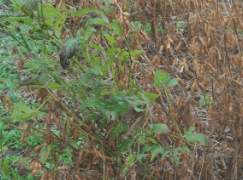
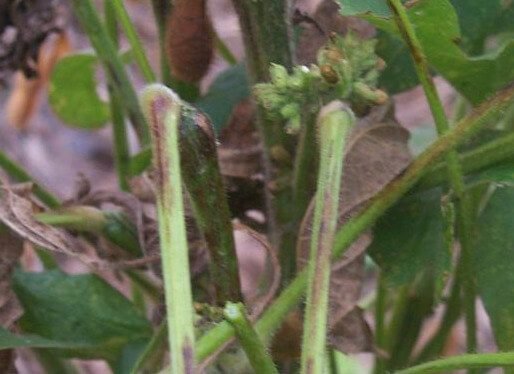
The TRSV virus affects tomato, soy, eggplant, tobacco, cucumber, lettuce, etc.
It is transmitted by ectoparasitic nematodes, specifically Xiphinema americana. In some host plants it is also transmitted by feeding insects, such as grasshoppers and thrips, as a result of their feeding.
- Leaves: Spots with yellow mosaic pattern, which lead to necrotic yellow and brown spots. Stunted growth.
- Trunks and stems: Watery spots and stripes.
- Fruits: Dark green spots. Fruit deformations
Cucumber mosaic (CMV)

It affects numerous crops such as celery, pepper, tomato and other vegetables. It also affects weeds and flowers. The symptoms of CMV are very similar to those of Tobacco Mosaic Virus.
The infection spreads through its insect vectors, in this case aphids.
- Tomato plants are usually stunted.
- Deformed leaves, or “fern leaves”, necrosis, petioles and stems, which can cause the death of the plant. Reduction of leaf limb.
- Ripening fruits have rings with annular cavities that remain yellow when ripe.
Bacterial diseases of tomato
Fungal diseases can cause significant losses in crop yield and quality, reducing the useful life of plants and limiting their production and marketing (for example, due to fruit malformations), causing large economic losses.
There are many diseases that can affect tomato cultivation: Leaf mold (Cladosporium fulvum), Rot caused by Alternaria alternata, Gray spot (Stemphylium solani), Smallpox (Septoria lycopersici), Bacterial freckle (Pseudomonas syringae), Bacterial spot (Xanthomonas campestris), Root or neck rot and wilting, wet stem rot caused by Sclerotinia spp., Neck and root rot (as a result of Phytophtora parasitica), Fusarium solani, bacterial cancer (Clavibacter michiganensis), basal stem rot caused by Sclerotium rolfsii, etc. But the following diseases stand out for their frequency:
Downy mildew or Late Blight (Phytophthora infestans)




This disease attacks the aerial part of the plant, at any stage of development, in conditions of high relative humidity (greater than 90%) and temperatures between 10ºC and 25º C.
- Leaves: Dark and irregular spots appear, initially oily in appearance, which over time necrotize on the leaves.In humid conditions appears on the underside of the leaves a fine white powder that corresponds to the spores.
- Stem: Elongated brown spots that symbol of necrosis and wilting on the plant.
- Fruit: Brown spots of unregulated contour, usually in the upper half.
- Tubercles: Gray or black spots that are reddish brown under the skin. They quickly rot from a secondary bacterial infestation and produce a very bad odor. Apparently healthy tubers will rot later, while stored for consumption or planting.
Powdery mildew (Leveillula taurica)
It is characterized by the presence of a mold, a whitish dust present mainly in the green organs of the plant (leaves, stems and fruits), which reduces the photosynthesis capacity of the plant.
It affects more than 1000 species of crops and weeds. Regarding crops, it mainly infects Solanaceae, such as tomae, pepper and eggplant



- Leaves: Initially you can see the white spots on the beam of the leaf, which become yellowish, and on the underside you can see a whitish powder. The spots increase in number and size, spreading from old leaves to young ones, hindering the development of the plant. In strong attacks of the disease, the leaves dry and detach, causing defoliation and, therefore, burns on the fruits, as they are directly exposed to the sun.
Alternariosis or early blight (Alternaria solani)


Warm temperatures of 24-29 ° C and high humidity favor the development of Alternariosis, which can occur at any time of the tomato growth cycle.
The pathogen can hibernate in soil and plant residues.
It spreads by contact, with splashes of water from the ground, running water, wind, work tools and machinery. It is manifested by the rotting of the fruits, although it can also affect the leaves, stem and petioles of the plant.
- Leaves: circular brown spots are generated, with concentric rings, up to half a centimeter in diameter. The affected areas turn yellow, then brown, and the leaves hang down. Spotting begins with the oldest leaves and then progresses upwards. The lesions are surrounded by a chlorotic halo due to the production of toxins.
- The whole plant can suffer defoliation and die. Stem and petiole: black and elongated lesions occur.
- Fruits: the spots are firm, sunken and sometimes with concentric rings, measuring 8 to 10 cm. On these lesions abundant fruiting occurs. The lesions can join destroying leaf tissue and affecting the quality of the fruit.
Gray rot or mold (Botrytis cinerea)



Botrytis is a parasitic fungus that mainly affects flowers and fruits, but also develops in stems, shoots and seeds. It is a necrophagous fungus, which affects more than 200 plants, mainly strawberries and fruits
More than temperature, it depends on high relative humidity. To develop requires mild temperatures of 15 to 25ºC and high humidity. The frequency of rain, that the surface of the plant remains wet for too long, favor the appearance of Botrytis in plants
A Botrytis infection will not become visible, as a rule, until two or three weeks after it began. If the infection can be observed with the naked eye, it means that the mold will have already penetrated the plant and it will not make sense to use a
- Leaves, stems and flowers: brown spots (grayish dust) are produced, which is the gray mycelium of the fungus.Brown lesions occur on leaves and flowers.
- In the fruits a soft rot occurs in which the gray and watery hairiness of the fungus is observed.
Botrytis is involved in what in winemaking is called “noble rot” which happens when more water evaporates from the infected grape due to the porosity of the infected ripe grapes. In that case, the wine will have a higher sugar content and more bouquet will not always cause damage.
Cladosporiosis (Fulvia fulva)



It affects many tomato crops more or less severely. It needs humidity conditions above 70% and temperatures between 5 and 25º C.
- Leaves: The first symptoms appear as spots ranging from green to yellowish on the back surface of older leaves. This coincides with the development of masses of conidia of the olive-green fungus on the lower surface of the leaf. As the disease progresses, the lower leaves turn yellow and fall off.
- The infected fruit develops a black, leathery rot at the tip of the calyx. It affects causing pale yellow spots on the bundle of leaves.
Fusarium oxysporu
It is the fungus that caused Panama Disease that caused serious losses in bananas of the Gross Michel class. The pathogen coolonizes the xylem ducts of the plant, blocking and plugging the vessels, which determines the appearance of symptoms of leaf wilting, yellowing and eventually necrosis and total death of the plant.
- Leaves: It produces wilting and yellowing that begins in the lower leaves and ends up drying the plant.
- Stem: If a cross section is made to the stem, a darkening of the vessels is observed.
Anthracnose (Colletotrichum spp.)
- Leaves: Leaf infections are rarely a problem, and are characterized by small circular lesions surrounded by a yellow halo, around the nerves
- Fruits: Anthracnose appears in the tomato when the fruits are in the process of ripening. Although the fruit is already infected when it is green, symptoms do not appear until it matures. On them appear circular spots of watery appearance (like rotten) that sink inwards. The center becomes even darker and rot increases.
- Roots: develop brown lesions with micro sclerotia on the root surface. This symptom has given it its common name: black root rot.

FuturCrop calculates short-term forecasts of the activity of 179 agricultural pests, based on accumulted temperature thresholds associated with critical stages of their life cycle.
FuturCrop forecasts indicate, for a given day, the stage of the pest’s life cycle and the day for the most efficient treatment.
More information
Tomato cultivation with good agricultural practices in urban and peri-urban agriculture. FAO
Tomato Spotted Wilt Virus of Tomato & Pepper, Utah Universit. Pest Fact Sheets
Tomato yellow leaf curl virus(TYLCV) EPPO Global Database
The NCSU Plant Disease and Insect Clinic provides diagnostics and control recommendations.
The NC State Extension Plant Pathology portal provides information on crop disease management.





